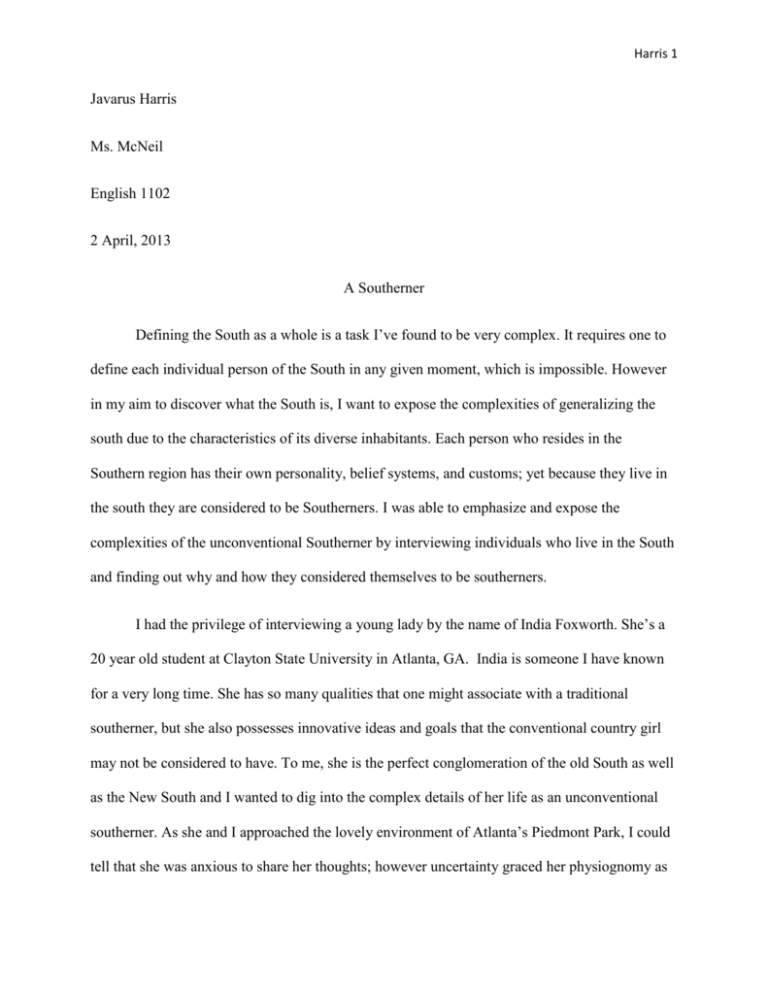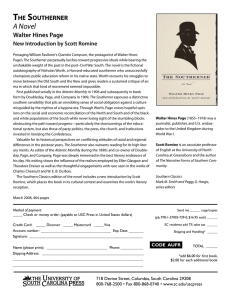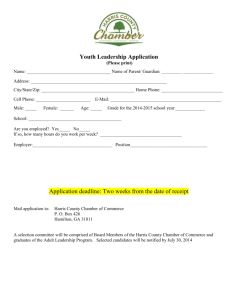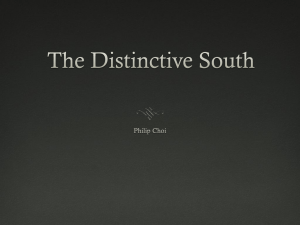A Southerner - New South Inside Out Project
advertisement

Harris 1 Javarus Harris Ms. McNeil English 1102 2 April, 2013 A Southerner Defining the South as a whole is a task I’ve found to be very complex. It requires one to define each individual person of the South in any given moment, which is impossible. However in my aim to discover what the South is, I want to expose the complexities of generalizing the south due to the characteristics of its diverse inhabitants. Each person who resides in the Southern region has their own personality, belief systems, and customs; yet because they live in the south they are considered to be Southerners. I was able to emphasize and expose the complexities of the unconventional Southerner by interviewing individuals who live in the South and finding out why and how they considered themselves to be southerners. I had the privilege of interviewing a young lady by the name of India Foxworth. She’s a 20 year old student at Clayton State University in Atlanta, GA. India is someone I have known for a very long time. She has so many qualities that one might associate with a traditional southerner, but she also possesses innovative ideas and goals that the conventional country girl may not be considered to have. To me, she is the perfect conglomeration of the old South as well as the New South and I wanted to dig into the complex details of her life as an unconventional southerner. As she and I approached the lovely environment of Atlanta’s Piedmont Park, I could tell that she was anxious to share her thoughts; however uncertainty graced her physiognomy as Harris 2 if she wasn’t completely sure of what she would say. She picked out a wooden picnic table for her and me to sit and converse opposed to the other modern steel tables strategically placed throughout the park. We opened up the conversation with greetings in which she replied with “How are ya?” Instantly I was stricken with a traditional Southern Bell impression just by the dialect and choice of phrase she chose to greet me with. She beamed with excitement and exuded pure hospitality following each response with “thank you” “my pleasure” and my favorite, “well if you don’t mind.” India was born in a small town by the name of Vidalia, GA. “We’re known all over the world for our sweet Vidalia onions” she exclaimed. She went on to explain the city of being a small “community environment” in which everyone knew each other and looked out for one another. “It’s the place I’ve felt most inclusive versus any other place I’ve been up North.” She talked about how any place that she moved she wanted to feel the community environment to some extent. She believes that warm feeling of togetherness can be found anywhere but mostly in the South. “I owe my traditional southern way of thinking and doing things to my hometown.” She says that it was in her original birth place where she developed a love for the outdoors and appreciation for the beauty of the land. “I used to play in the field behind my grandparents house as a little girl chasing my dog, Lithonia” laughingly she stated, “I was like a little prairie girl after school.” It was interesting to me to hear her talk about her childhood; it was if she grew up in a time period years before she actually did. I was able to understand why she labeled herself as a country girl at heart. Her childhood was a replica of what we see on old television shows through the perspective of how the world views the south and its residents to be. When India begun high school she possessed new interests in addition to her love for the southern country, she grew an interest in fashion. Usually when you think of high fashion Harris 3 couture designers, you don’t naturally associate them with the backwoods of Georgia. “People who know about my country childhood lifestyle are shocked when I tell them about my fascination with high fashion designers, and the people who only know about my goals to be a designer are shocked to know about my country roots.” The south is not typically known for being in accordance with the latest trends of the world so to witness someone who is truly a southerner have such a passion for what one may consider a “Northern” tradition goes against the idea that all southerners have a rural sense of style. “It’s amazing to me how people like to categorize the south with one depiction when not all of us fit that image.” The image that we often refer to when speaking about the perception of the south relates to the traditions and customs of Southerners from an earlier time period; this time period is identified as the Old South. The Old South represents an era in history of which the Southern region adopted his own way operating. There was a caste system that distinctively separated individuals or groups according to several different characteristics of their lives, but especially their race. There was a certain coexistence between African Americans and Whites in which the typical white man would own slaves who where black and he was understood to be inferior to them. This was also a time were education was not as prominent and accessible as today’s time, especially to women. However in the North during this period, they did not own slaves and blacks were considered to be household workers or worked on farms as employees but not as slaves. Education was on a wide spread creating a more industrialized economy than in the south. “I believe that so much of how we (southerners) are viewed reverts back to the staple the Old South put on society during its time.” India stated. It’s obvious to see that today the South has become a more industrialized place all while preserving its cultural content; this is the New Harris 4 South. “It’s always kind of funny to me when I’m coming into the city of Atlanta from home in Vidalia, I go from seeing fields of rich soil with big beautiful Oak trees to an expansion of lanes and an evolution of tall buildings and sidewalks.” In accordance to the geographic growth, racial equality has spread throughout the South and is more secure. It has opened a portal for racial diversity in the region that welcomes all nationalities, races, and creeds along with their belief systems, customs and behaviors. “Growing up I’ve moved to several different cities in the South. While some of those cities upheld a community and family environment, others displayed the intense separation of races…black against white.” India went on to express her new found love for the racial harmony that existed in Atlanta, the city that serves as the pivot point to Georgia. “Some of my friends from high school found it strange when I told them my best friend was an Asian.” She noted. “I would reply to them by telling them I invite you to come out of that old way of thinking and step into reality. India says that her Asian friend, Kelly, is the best friend that she’s ever had, including any of her African American friends. She says, “It’s not because Kelly is Asian that makes her a good friend to me, but because she’s a spectacular person and that’s all that should matter.” “I don’t let the perceptions of what one might think a Southerner is define who I am, instead I define aspects of what it means to be a Southerner just because of who I am.” India Foxworth is a country girl who grew up in the back woods of Georgia. She loves the outdoors and doesn’t mind getting her hands dirty. She’s an African American who is best friends with an Asian. Whenever she’s not working in her grandparent’s farm, she is using her spare time to study her favorite high fashion designers, Louis Vuitton and Manolo Blahnik. She has a thick southern accent and dreams of going to Paris one day for its annual fashion week. All her characteristics uniquely intertwine to make her the unconventional Southerner that she is today, Harris 5 just like many others who reside in the South. To put one specific definition to the term Southerner is far too complex. However it’s safe to say that the South represents the diverse community. Not really sticking to one way of operation, but instead creating its own way of life.








